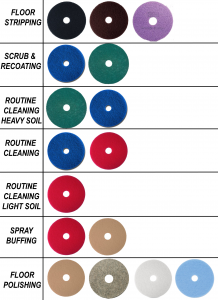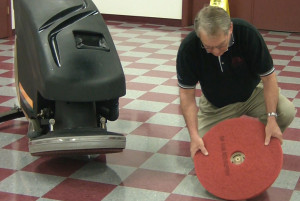HOW TO SELECT THE CORRECT COLOR FLOOR PAD
![By Supergolfdude (Own work) [CC BY-SA 4.0 (http://creativecommons.org/licenses/by-sa/4.0)], via Wikimedia Commons Phil_&_Jim_-Bones-_MacKay_2014 By Supergolfdude (Own work) [CC BY-SA 4.0 (http://creativecommons.org/licenses/by-sa/4.0)], via Wikimedia Commons](https://www.nclonline.com/blog/wp-content/uploads/2015/06/Phil__Jim_-Bones-_MacKay_2014-300x236.jpg)
Professional Championship Golfer Phil Mickelson consults with longtime caddy Jim “Bones” MacKay (Wikimedia Commons)
You better believe there is a well thought out determination on which club to select. Variables such as the ball’s position on the course, the terrain of its location on the course, and distance from the hole play into the selection process.
The same can be said for a facility’s floor maintenance staff prior to the start of their work.
Choosing a dust mop, damp mop, bucket, or automatic scrubber may be easy due to limited options available in the supply storage area of a facility. The selection of the appropriate chemicals is facilitated by the manager in charge of purchasing, who chooses which stripper, which buffer, or which neutral cleaner to use. But, it’s the choice of which floor pad to use that can leave many novices scratching their head. Just like a newcomer to golf could be initially confused and intimidated by the plethora of club choices; newcomers to a floor maintenance staff may have similar feelings when being presented with a choice of so many different colored floor pads. Seasoned pros sometimes forget the details that confuse and intimidate rookies, but they need to remember that the colorful assortment of floor pads can be as initially confusing as that wide variety of clubs in a golf bag for a beginner.
Floor pads are different colors for a reason. When dealing with pads for low speed machines (fewer than 1500 rpm’s), each color identifies the pad’s intended purpose. The darker the pad, the more open the pad’s weave is, allowing it to “cut” into the floor finish. Black pads are the traditional pads used for floor stripping, with its loose weave allowing it cut into and break up the layer(s) of finish on a floor. Other dark colors, brown and purple, are also used for stripping.
Green pads are multi-purpose pads, as they can be used during a strip and coat process or also to clean floors with a heavy soil load. To scrub floors with a medium soil load, most floor techs opt for a blue pad. Red pads are also multi-purpose, as they are the pads of choice for routine cleaning floors with low soil loads and also for use while spray buffing. As the pads moved down the color spectrum, from black to brown to purple to green to blue, and to red, the weave became tighter and less abrasive. Once pads go lighter in the color scale than red, then the pads start to exhibit tight weaves and are used primarily in polishing. Light green, beige/tan, or natural pads are slightly aggressive and good for polishing floors with a hard finish. When a floor has a soft finish, floor techs must be especially careful about scratching, swirling, or color bleed through while polishing. For that reason, light pink or white pads are the correct choices for polishing floors finished with the softer films. The most delicate of applications typically call for the white pads. Also, textured surfaces, such as concrete require polishing pads more aggressive and tougher than white pads.

Chart illustrating typical pad colors for each particular procedure. Pad colors can vary dependent on manufacturer with UHS burnishing pads
If a facility has a high speed burnisher instead of a traditional floor machine, then the traditional color schemes may not apply. Manufacturers of ultra-high-speed (UHS) burnishing pads may deviate on the color designations from those of traditional swing machine pads. Check with the manufacturer of your UHS pads to determine which pads are best used in which applications. Factors such as the speed of the machine, power source of the burnisher (battery, electric, or propane), and the characteristics of the flooring surface all must be factored into the final determination of which is the appropriate floor pad.
Whether or not the facility in question uses a standard floor machine, a UHS burnisher, or both, proper procedures must always be followed. Floor maintenance personnel must follow the specified start up procedures and always adhere to safety precautions at all times. Following use of the floor pads, the proper care, maintenance, and storage there of need to be included in their final activities.
There will always be misconceptions about how long a floor pad should last. Some believe they are disposable and discard them after each use, which results in a lot of money being wasted. At the other end of the spectrum, there are those who believe the pads will last forever. While they may be saving their company money in the short term, they are costing their company more money in the long term, since after a certain period, the pad becomes worn out and loses its effectiveness. Meanwhile, the floor is not getting the proper care it requires, since the pads are, by this point, useless. Floor techs must be able to notice when a pad is starting to lose its effectiveness and its time to flip over on to the reverse side. If the pad has already been used on the other side, then it is time for a replacement.
Ensuring that the proper colored pads are used in the appropriate circumstance is a team effort. Just like a caddy is part of a golfer’s team and plays a role in which club to select on a given shot, supervisors play a role in the success or failure of their floor tech staff. Supervisors should ensure their staff is properly trained in all aspects of their job functions and offer training and instruction in those areas where proper knowledge is lacking.
19th HOLE
National Chemical Laboratories produces 270 world class cleaning solutions in multiple categories for many different types of facilities. While NCL primarily deals with chemical cleaning solutions, there is one floor pad from NCL that defines multi-purpose. AQUA MAGIC pads may not follow the typical color scheme for floor pads, and that is because the multitude of functions does not allow individual selective placement in one category.
AQUA MAGIC pads can be used not only with low speed floor machines and automatic scrubbers, but they also respond well to battery, electric, or propane powered UHS burnishing machines. AQUA MAGIC pads are made with an open weave design with a rubberized texture for added density. Aside from the impressive results from AQUA MAGIC pads on newly buffed VCT surfaces, AQUA MAGIC pads are a pad of choice when working on many different stone flooring surfaces as well.
To find out more information on NCL Aqua Magic pads, click here
 English
English Español
Español

